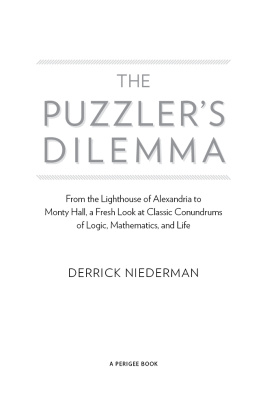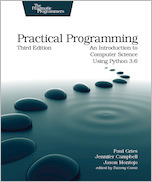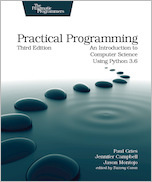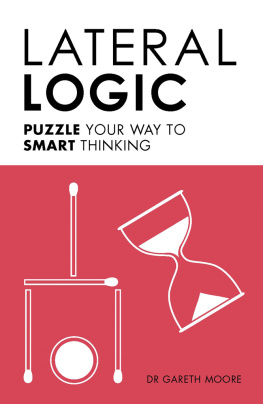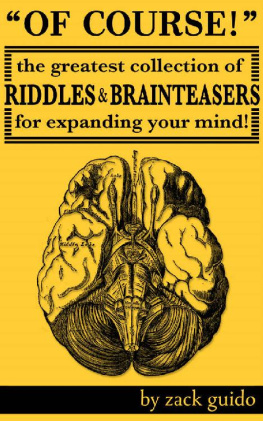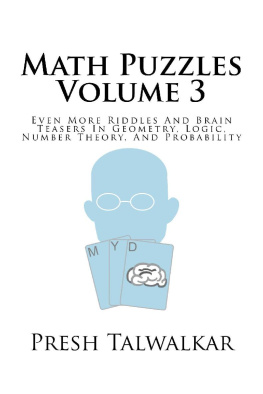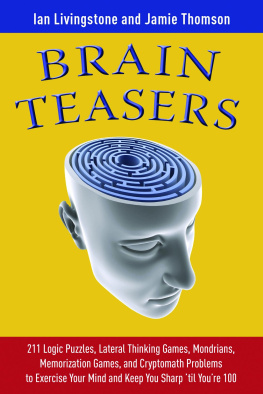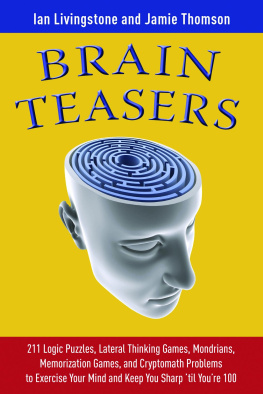THE
PUZZLERS
DILEMMA

THE
PUZZLERS
DILEMMA

From the Lighthouse of Alexandria to
Monty Hall, a Fresh Look at Classic Conundrums
of Logic, Mathematics, and Life
DERRICK NIEDERMAN
A PERIGEE BOOK
A PERIGEE BOOK
Published by the Penguin Group
Penguin Group (USA) Inc.
375 Hudson Street, New York, New York 10014, USA
Penguin Group (Canada), 90 Eglinton Avenue East, Suite 700, Toronto, Ontario M4P 2Y3, Canada
(a division of Pearson Penguin Canada Inc.)
Penguin Books Ltd., 80 Strand, London WC2R 0RL, England
Penguin Group Ireland, 25 St. Stephens Green, Dublin 2, Ireland (a division of Penguin Books Ltd.)
Penguin Group (Australia), 250 Camberwell Road, Camberwell, Victoria 3124, Australia
(a division of Pearson Australia Group Pty. Ltd.)
Penguin Books India Pvt. Ltd., 11 Community Centre, Panchsheel Park, New Delhi110 017, India
Penguin Group (NZ), 67 Apollo Drive, Rosedale, Auckland 0632, New Zealand
(a division of Pearson New Zealand Ltd.)
Penguin Books (South Africa) (Pty.) Ltd., 24 Sturdee Avenue, Rosebank, Johannesburg 2196, South Africa
Penguin Books Ltd., Registered Offices: 80 Strand, London WC2R 0RL, England
While the author has made every effort to provide accurate telephone numbers and Internet addresses at the time of publication, neither the publisher nor the author assumes any responsibility for errors or for changes that occur after publication. Further, the publisher does not have any control over and does not assume any responsibility for author or third-party websites or their content.
Copyright 2012 by Derrick Niederman
Text design by Tiffany Estreicher
All rights reserved.
No part of this book may be reproduced, scanned, or distributed in any printed or electronic form without permission. Please do not participate in or encourage piracy of copyrighted materials in violation of the authors rights. Purchase only authorized editions.
PERIGEE is a registered trademark of Penguin Group (USA) Inc.
The P design is a trademark belonging to Penguin Group (USA) Inc.
First edition: March 2012
Perigee trade paperback ISBN: 978-0-399-53729-5
Library of Congress Cataloging-in-Publication Data
Niederman, Derrick.
The puzzlers dilemma: from the Lighthouse of Alexandria to Monty Hall, a fresh look at classic conundrums of logic, mathematics, and life / Derrick Niederman. 1st ed.
p. cm.
ISBN: 978-1-101-56087-7
1. Mathematical recreations. 2. Logic, Symbolic and mathematical. I. Title.
QA95.N483 2012
511.3dc23
2011042319
PRINTED IN THE UNITED STATES OF AMERICA
10 9 8 7 6 5 4 3 2 1
Most Perigee books are available at special quantity discounts for bulk purchases for sales promotions, premiums, fund-raising, or educational use. Special books, or book excerpts, can also be created to fit specific needs. For details, write: Special Markets, Penguin Group (USA) Inc., 375 Hudson Street, New York, New York 10014.
ALWAYS LEARNING
PEARSON
ONE
IN THE BEGINNING
T he year was 280 BC, plus or minus, and Greek architect Sostratus of Cnidus faced a dilemma that pitted his pride against his life expectancy. The crowning achievement of his career, the Lighthouse of Alexandria, was nearing completion, and Sostratus wanted nothing more than to inscribe his name somewhere on its base. The good news was that there was an abundance of unsullied real estate from which to choose. The lighthouse, destined for superstardom as one of the Seven Wonders of the Ancient World, stood some 400 feet above the island of Pharos in Alexandria Harbor, making it one of the most massive buildings on the planet. The snag was that Ptolemy II Philadelphus, the king of Egypt, had decreed a precise spot for the inscription and insisted that his name be the one to occupy it.
Ptolemy II, not unlike Ptolemy I or any Egyptian pharaoh you might happen to think of, lived life by his own set of rules. His moniker of brotherly love derived from his second wife, his full sister. Upon her death, he ordered a deification march in which chariots were led by teams of elephants, lions, leopards, camels, and ostriches, with a bear and rhinoceros thrown in for good effect. His public display of grief was followed by a return to his private concubines. All of which is to say that Ptolemy was a man accustomed to getting his own way, and the penalty for insubordination was high. Nonetheless, as the legend goes, Sostratus was able to chisel for future generations a lengthy inscription that bore his own name. The puzzle is to figure out how he did it without winding up at the bottom of the Mediterranean.
Dont worry. You can keep on reading, because the answer wont be divulged just yet. Where puzzles are concerned, there is nothing worse than being spoon-fed the answer before your wits have been given a fighting chance. Here we will stretch to the opposite extreme, because were going to go on a toura puzzle-solving tour, if you willwith all of its red herrings, false hopes, and frustrations.
Many puzzles, and certainly those crafted from quasi-historical events, must be worded just so. If a puzzles crafting eliminates all possible ambiguities, the exploration is over before it really starts, a circumstance only slightly less vexing than an accidental glimpse of the answer. At the other extreme, if the wording is too vague, solvers can become distracted by all sorts of oddball theories and wont be able to track a clear path to the solution. For the puzzle at hand, you might seize on the notion that the names of Ptolemy and Sostratus could be connected by an ambigram or some other form of clever typography. Or, in a particularly weak moment, you might concoct an inscription such as To the great pharaoh Ptolemy II, who commissioned this lighthouse so stratus clouds would not impair navigation. Nice try. Sort of. Lame wordplay is not the stuff of great puzzles, and stratus clouds werent designated as such until many centuries later. This type of silliness could have been snuffed out right away had the statement of the puzzle included what legend holds to be the actual inscription: Sostratus, son of Dexiphanes of Cnidus, to the gods who protect those at sea.
In attempting to solve a classic puzzle, we can either go italone or use Isaac Newtons technique of standing on the shoulders of giants. Our giant of choice is the late, great Hungarian mathematician George Plya, long-time professor at Stanford University. Plyas domains of expertise included probability, combinatorics, and many other branches of higher mathematics, but he spent the latter stages of his 97-year life trying to identify and characterize the essential elements of problem solving. In his seminal work How to Solve It, first published in 1957, Plya gave the following advice to people just starting out on a problemin other words, people like us. Do you know a related problem? asked Plya. Here is a problem related to yours and solved before. Could you use it? Could you use its result? Could you use its method? Should you introduce some auxiliary element in order to make its use possible? Taking the advice of a giant to heart, it remains tempting to think that the Lighthouse of Alexandria puzzle must revolve around some sort of hidden message or quirk of language because subsequent history oozes with such examples. For an example with a special parallel with Sostratus, we fast-forward two millennia to a gentleman named Arthur OConnor, a prominent figure in the 1798 Irish Rebellion.

